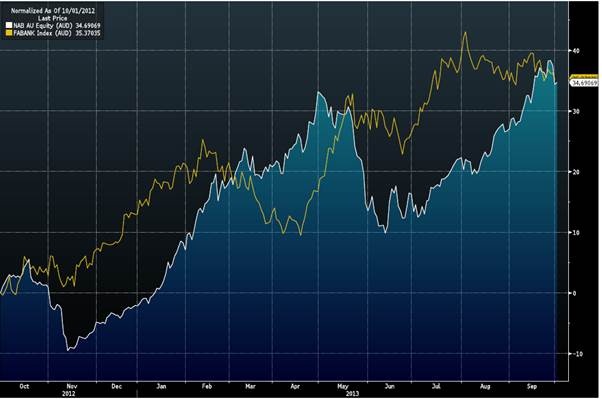Will NAB's Clydesdale start pulling its weight?
It is expected the Reserve Bank of Australia will keep the finger on the pause button at today’s meeting. Holding steady should hush opinions that we are in a property bubble and credit risks facing Australian banks are on the up.
Investors have calmly dismissed any concerns associated with a supposed property bubble and have propelled the financials index up 29 per cent over the past year.
The threat of credit risk has suppressed UK and European banking shares for as long as investors can remember. As a result, investors and commentators bashed the National Australia Bank as the ugly duckling investment of the Big Four due to its ownership of UK-based bank Clydesdale.
How times have changed. The past 12 months has seen NAB as the best performing Big Four bank, posting a total return of 44 per cent.
Critics have pointed the finger at NAB’s UK banking business, Clydesdale, for the poor performance. Until recently, investors punished NAB for this too.
Confidence and a new-found stability in UK and European banks have yanked both banking sectors higher in the past year. The UK bank index has climbed 35 per cent in Australian dollar terms, putting it ahead of the glorified Australian financials index.
All of this is good news for NAB. The past four months has seen NAB (white line) close in on the UK banking index (yellow), suggesting investors are becoming more comfortable with the bank’s exposure to Clydesdale.

Why there has been so much criticism in the first place is rather astounding. Of NAB’s net profit reported for the half-year ending in March, NAB’s UK banking exposure through Clydesdale Bank only accounted for 2.4 per cent. A drop in the ocean really.
Admittedly, the number could have contributed more to cash earnings. Clydesdale isn’t the most efficient bank, with a cost-to-income ratio at 70 per cent. As a group, NAB has a cost to income ratio of 41 per cent. If NAB can clean up those UK numbers, it will benefit from what looks to be an economic resurgence in the UK.
Reports from government bodies, including APRA and the RBA, have had Australian banks and global banks in the firing line. It would appear credit risks for Australian’s favourite investments — the Big Four banks — are overdone in light of premature speculation about a property bubble.
For NAB, the future looks bright — especially with a resurgence in Clydesdale.













